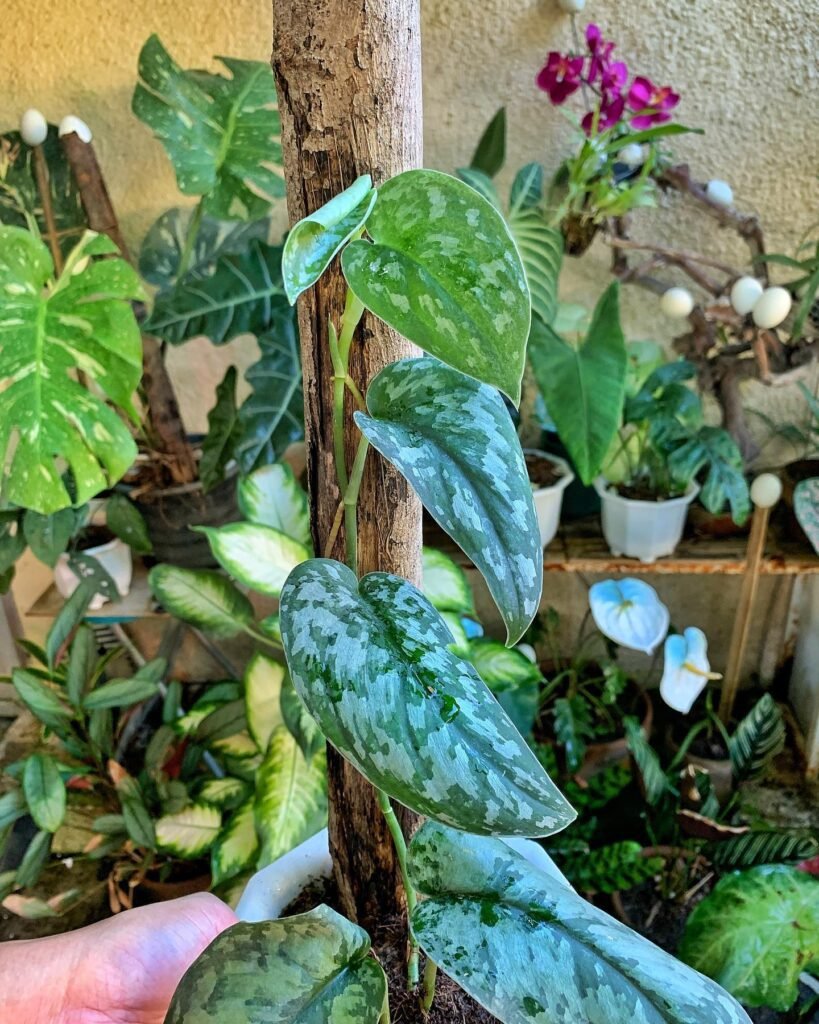Hello, plant enthusiasts! Today, I want to introduce you to a stunning indoor plant that will add a touch of natural beauty to your home decor – Scindapsus pictus, also known as Silver Vine Pothos. If you’re looking for an easy-to-grow, decorative houseplant, you’ve come to the right place. Let me guide you through the care and maintenance of this gorgeous foliage plant.
Scindapsus pictus is a member of the Araceae family and hails from Southeast Asia. Its heart-shaped leaves with silvery grey variegation create a unique and striking appearance. With its trailing habit, it’s perfect for displaying in hanging planters or training it to climb on moss poles, creating a cascading effect.
When it comes to plant care, Scindapsus pictus is a real winner. It is one of those easy-to-grow indoor plants that thrives in bright indirect light, making it suitable for various indoor spaces. No need to worry about providing direct sunlight – this silver vine pothos prefers its light to be filtered.
Now, you may be wondering, why Scindapsus pictus? Well, not only is it a beautiful houseplant, but it also adds a touch of nature to your indoor spaces. It’s a reminder of the great outdoors, even if you’re in the heart of the city. So, why not bring this silver vine houseplant into your home and create a natural oasis?
Appearance of Scindapsus pictus (Silver Vine Pothos)
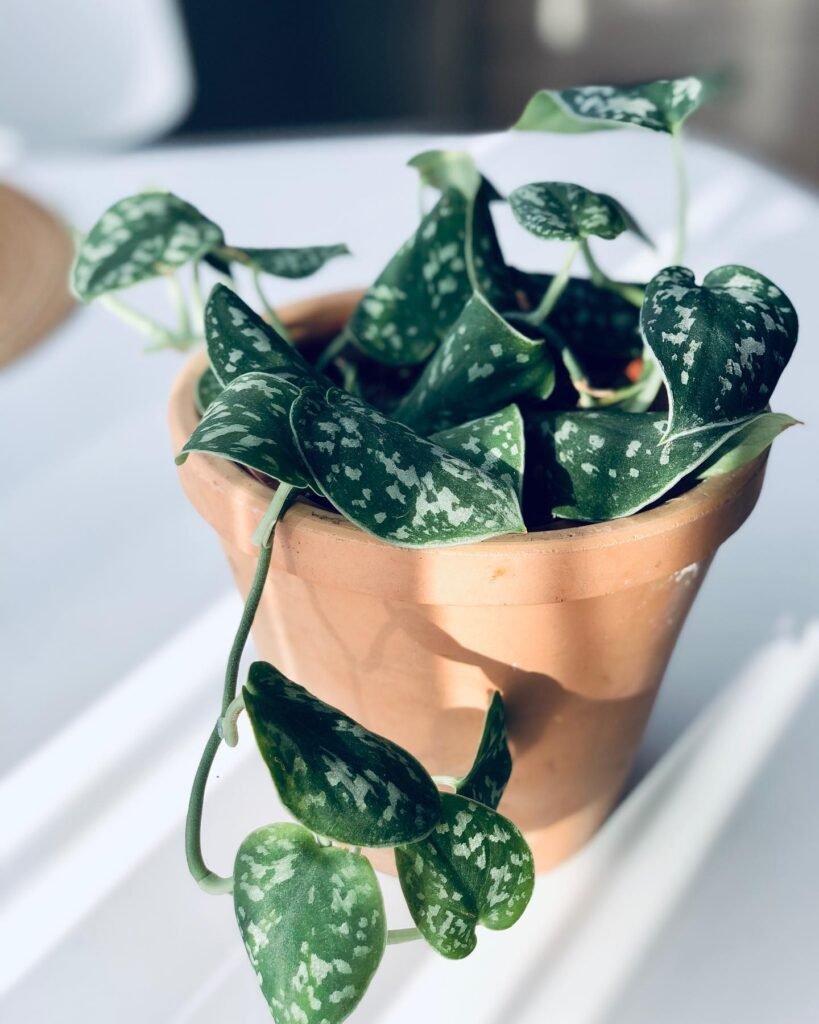

Scindapsus pictus, or Silver Vine Pothos, showcases a visually striking appearance with its unique features. The plant’s heart-shaped leaves are beautifully adorned with silvery grey variegation, adding a touch of elegance to any space. The intensity of the variegation may vary depending on the cultivar, offering a range of patterns to choose from. With its trailing habit, Silver Vine Pothos can be trained to climb on moss poles or displayed in hanging planters to create a cascading effect, enhancing the aesthetic appeal of your indoor decor.
 The Scindapsus pictus, also known as the Silver Vine Pothos, is a real-life Tarzan. In the wild, it climbs trees with aerial roots, and at home, it beautifully hangs or climbs, showcasing its adaptability and wild essence right in your living room.
The Scindapsus pictus, also known as the Silver Vine Pothos, is a real-life Tarzan. In the wild, it climbs trees with aerial roots, and at home, it beautifully hangs or climbs, showcasing its adaptability and wild essence right in your living room.
Light Requirements for Scindapsus pictus
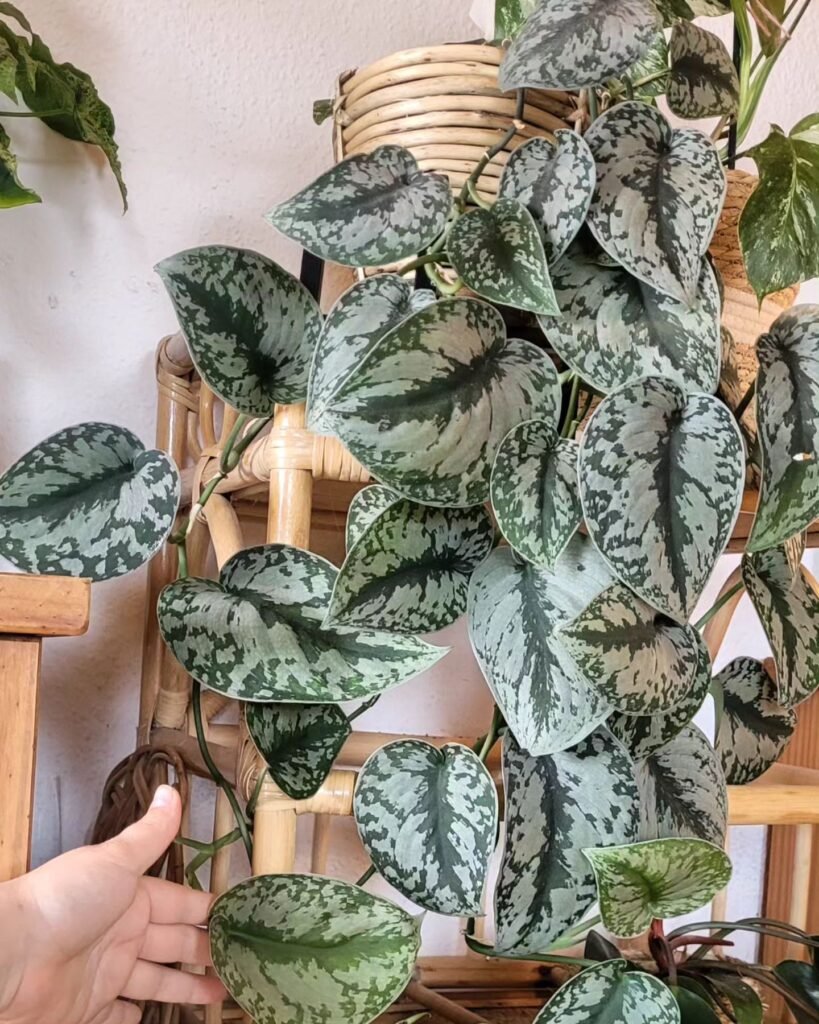
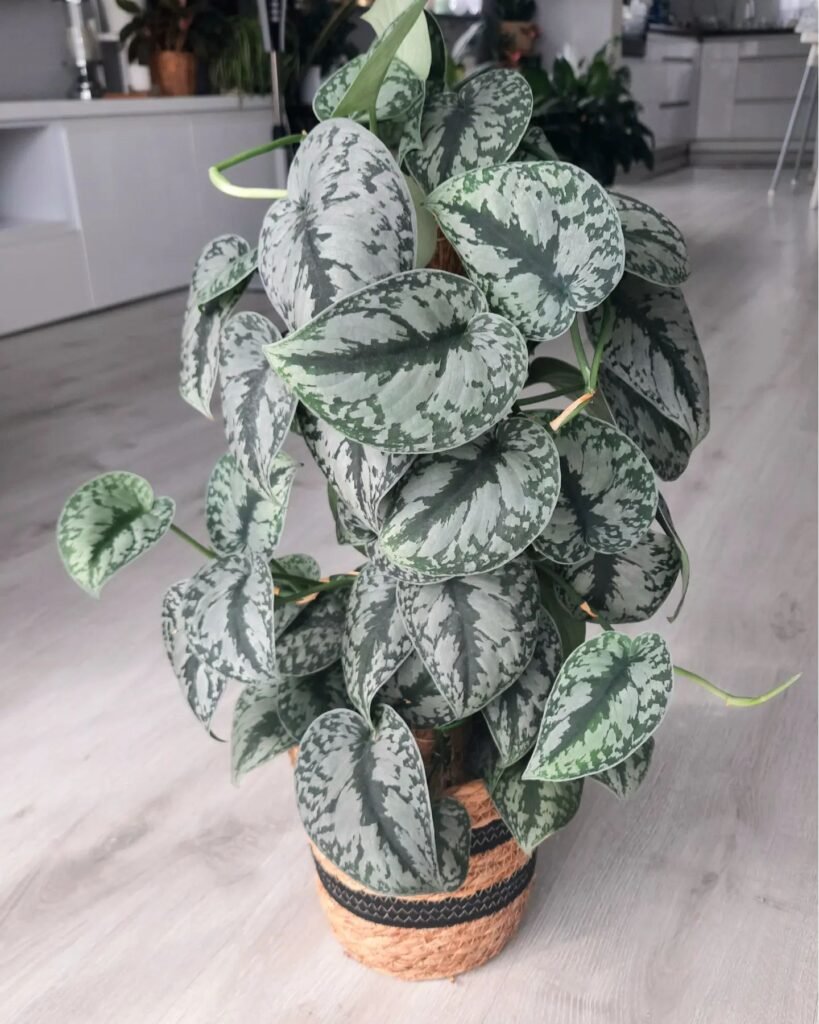
Scindapsus pictus, or Silver Vine Pothos, is an indoor plant that thrives in medium to bright indirect light. While it can tolerate low indirect light, it prefers to be placed in a location with bright, indirect sunlight. It’s important to note that direct sunlight can harm the leaves and cause them to lose their beautiful variegation. To provide the ideal light conditions for your Scindapsus pictus, consider placing it near a north or east-facing window where it can receive bright, indirect sunlight.
To protect the plant from the potential harm of direct sunlight, it is recommended to use curtains or blinds to filter the light. This will ensure that your Scindapsus pictus receives the adequate light it needs without any negative effects on its foliage. By providing the right amount of light, your Silver Vine Pothos will continue to thrive and showcase its stunning silvery grey variegation.

Watering Tips for Scindapsus pictus (Silver Vine Pothos)
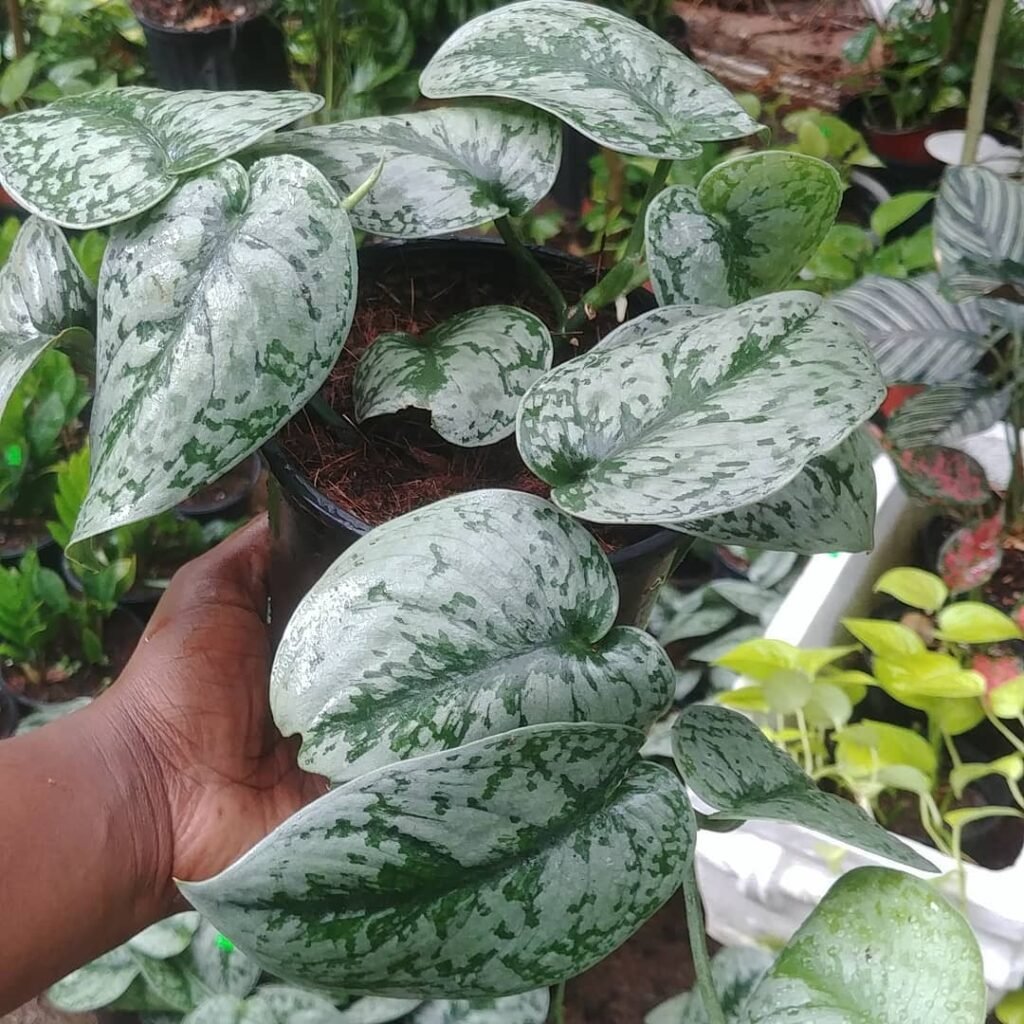
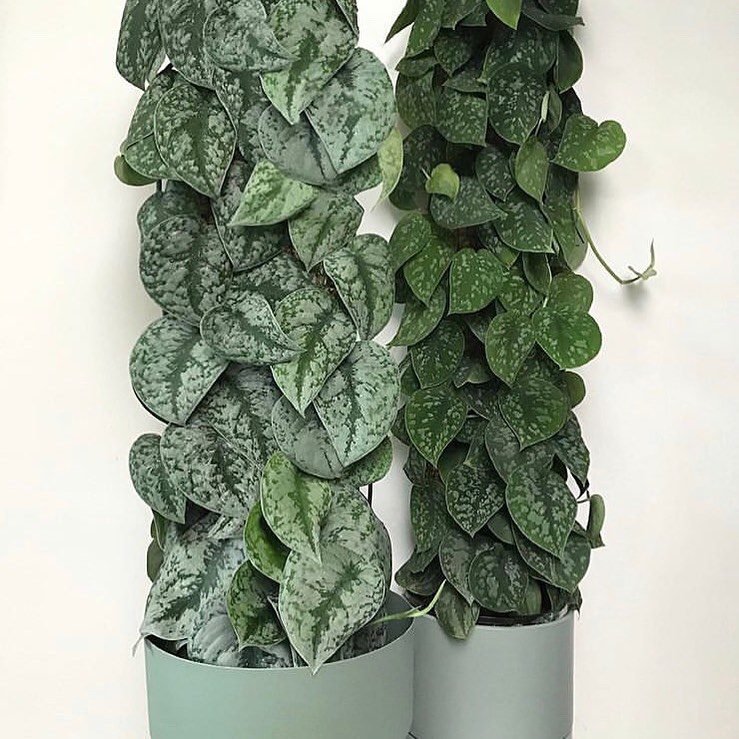
When it comes to caring for your Scindapsus pictus, proper watering is crucial. Here are some essential tips to keep in mind:
- Monitor soil moisture: Check the top two inches of the soil regularly to determine if it is dry. Scindapsus pictus prefers the soil to dry out slightly between waterings.
- Water slowly and deeply: When watering, make sure to do it slowly and deeply to ensure that the water reaches the root zone. This helps prevent water from pooling on the surface and encourages healthy root growth.
- Avoid overwatering: Overwatering can lead to root rot, so it’s important to avoid saturating the soil. Allow the excess water to drain out and never let the plant sit in standing water.
- Prevent underwatering: On the other hand, underwatering can cause the plant to wilt and the leaves to turn yellow. Make sure the soil doesn’t dry out completely and adjust the watering frequency accordingly.

Fertilizing and Soil for Scindapsus pictus
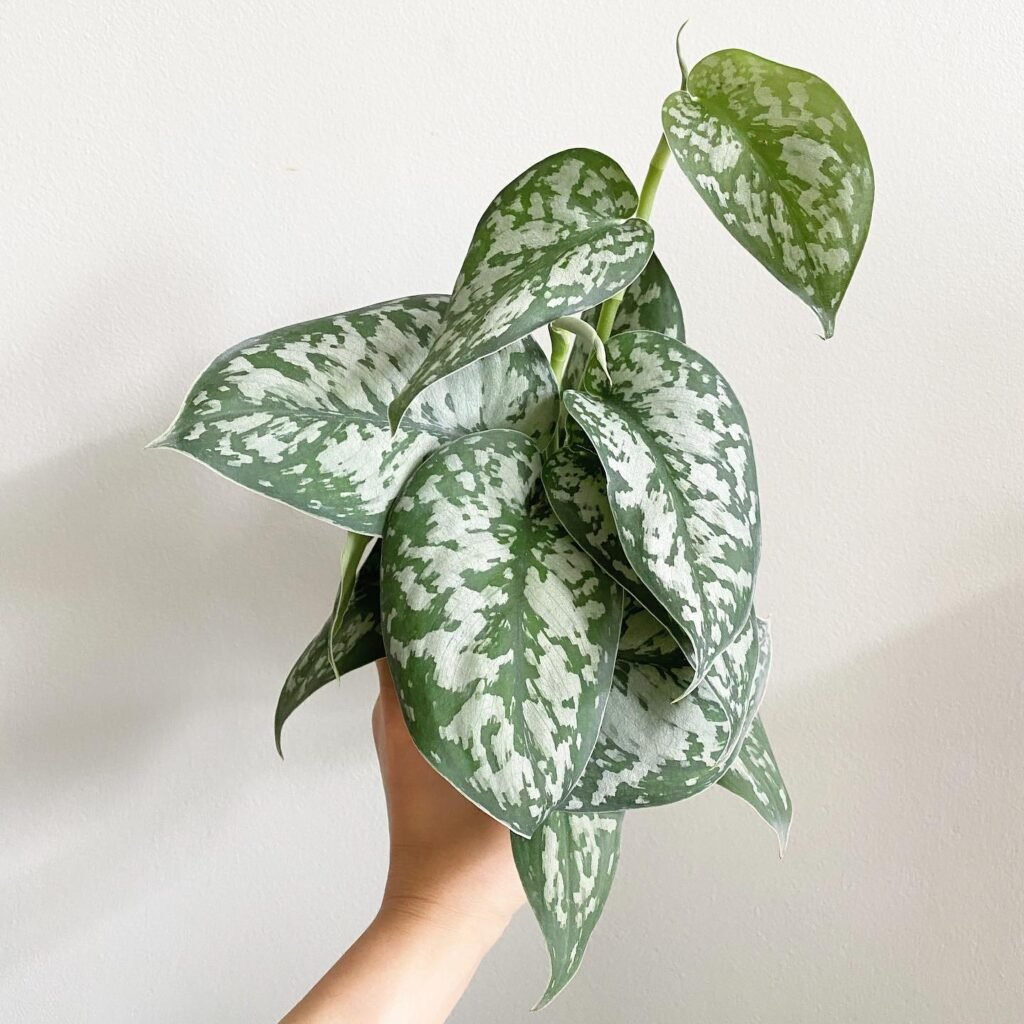

When it comes to the care of Scindapsus pictus, providing the right soil and fertilization is key. This stunning silver vine pothos thrives in well-draining soil that is rich in organic matter.
“Using a commercial indoor potting mix specifically formulated for houseplants is highly recommended,” says Emily Green, a renowned indoor plant expert. “This type of soil provides good drainage, which is essential for the health of your Scindapsus pictus. It also contains the necessary nutrients to support the plant’s growth.”
In terms of fertilization, an important aspect of silver vine pothos care, it is best to use a water-soluble complete houseplant fertilizer. Fertilize your Scindapsus pictus once a month during the growing season to ensure optimal foliage and growth.
Choosing the Right Soil
- Opt for a well-draining soil mix specifically formulated for indoor plants.
- Look for a soil mix rich in organic matter to provide essential nutrients.
- Avoid heavy soils that retain excessive moisture, as they can lead to root rot.
- Consider adding perlite or sand to improve drainage, especially if your soil mix is not well-draining.
Houseplant Fertilizer
When selecting a fertilizer for your Scindapsus pictus, choose a water-soluble complete houseplant fertilizer with a balanced ratio of nutrients.
- Look for a fertilizer with equal amounts of nitrogen, phosphorus, and potassium (N-P-K ratio of 10-10-10).
- Apply the fertilizer once a month during the growing season, following the manufacturer’s instructions for dilution and application rates.
- Be cautious not to over-fertilize, as it can cause fertilizer burn and damage the roots.

Pruning and Maintenance for Scindapsus pictus
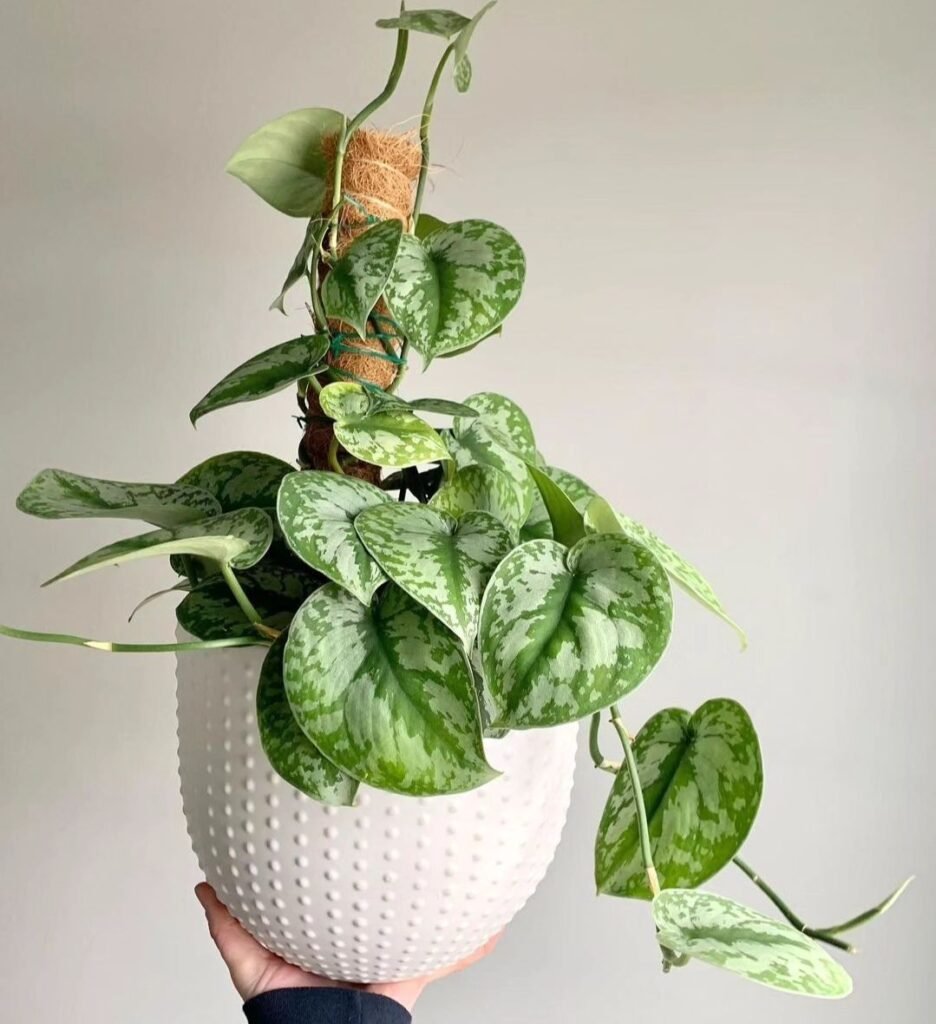
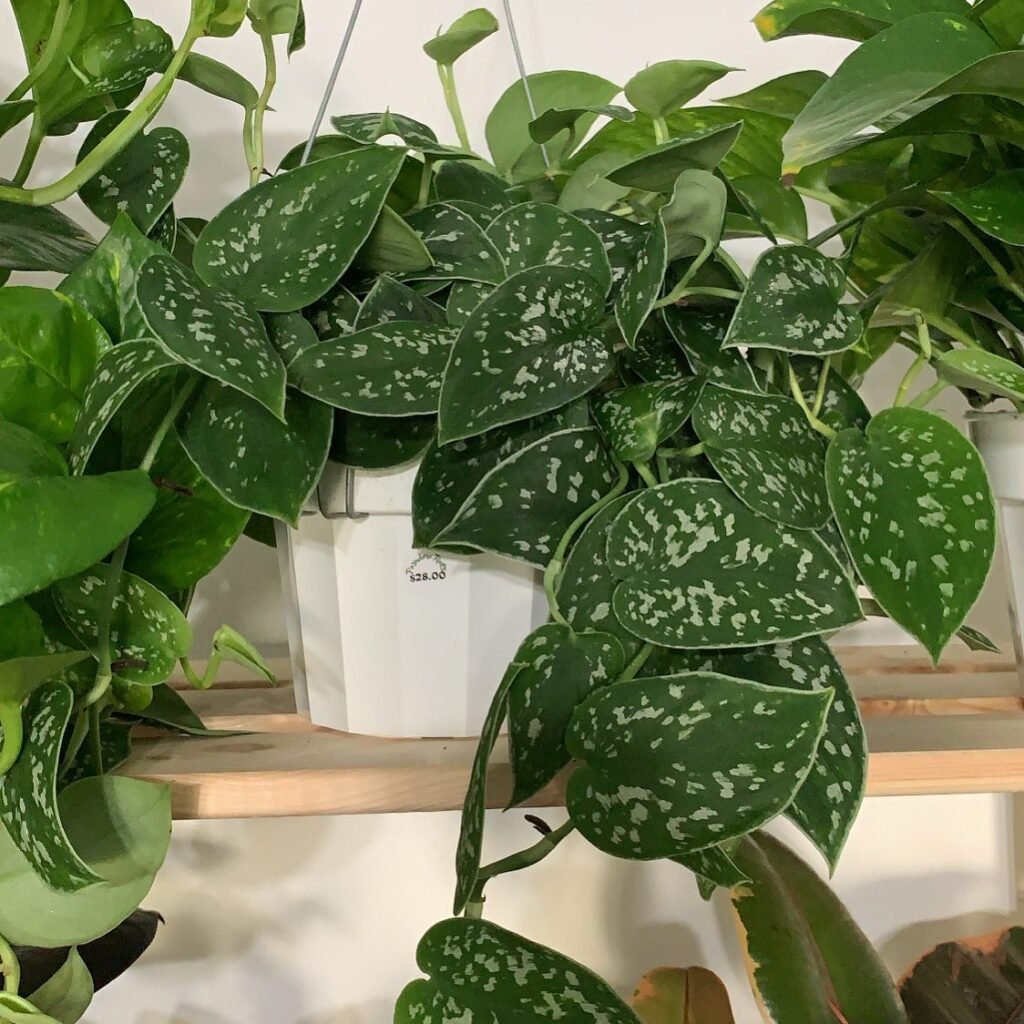
When it comes to keeping your Scindapsus Pictus, or Silver Vine Pothos, in top shape, pruning and maintenance play a crucial role. Regular pruning not only helps maintain the plant’s health but also promotes lush growth and an attractive appearance. Here are some essential tips to keep in mind for pruning and maintaining your Scindapsus Pictus:
1. Removing Damaged Leaves:
To ensure the overall health of your Scindapsus Pictus, it’s important to remove any damaged or dead leaves. Using clean and sharp pruning shears, snip off the affected leaves at their base. This helps prevent the spread of diseases and allows the plant to focus its energy on new growth.
2. Controlling Size and Shape:
If your Scindapsus Pictus has become too long or sparse, pruning can help control its size and shape. Trim back the vines to encourage a bushier growth and a more compact appearance. You can also guide the plant to climb on moss poles or trellises for added vertical interest.
3. Pruning Timing:
The best time to prune your Scindapsus Pictus is in the spring when new growth starts to emerge. Pruning during this time encourages fresh foliage and helps the plant maintain a healthy and vibrant appearance throughout the growing season.
Pro Tip: When pruning, always make clean cuts just above a leaf node. This encourages new growth at the node and prevents unsightly stubs.
Pruning is an excellent opportunity to assess the overall health of your Scindapsus Pictus. Take the time to inspect for any signs of pests or diseases and address them promptly to keep your plant thriving.
Maintaining your Scindapsus Pictus also involves regular care and attention. Keep an eye on the moisture level of the soil, ensuring it stays evenly moist but not waterlogged. Regularly check for pests and provide the appropriate care, such as adjusting lighting conditions or increasing humidity, as needed.

Propagating Scindapsus pictus (Silver Vine Pothos)
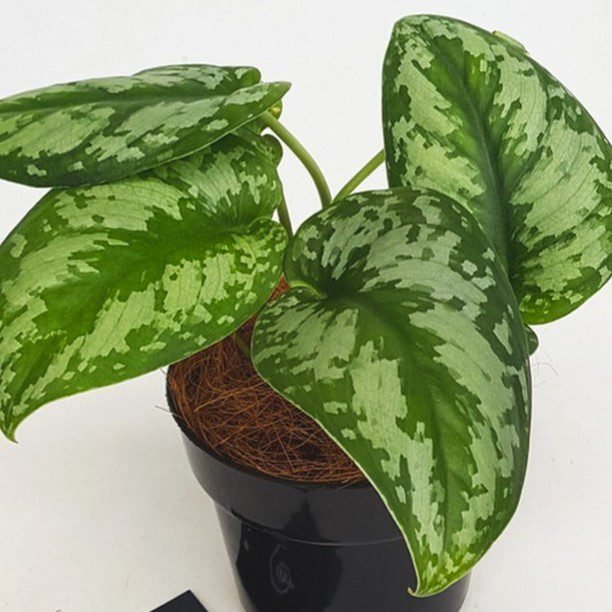
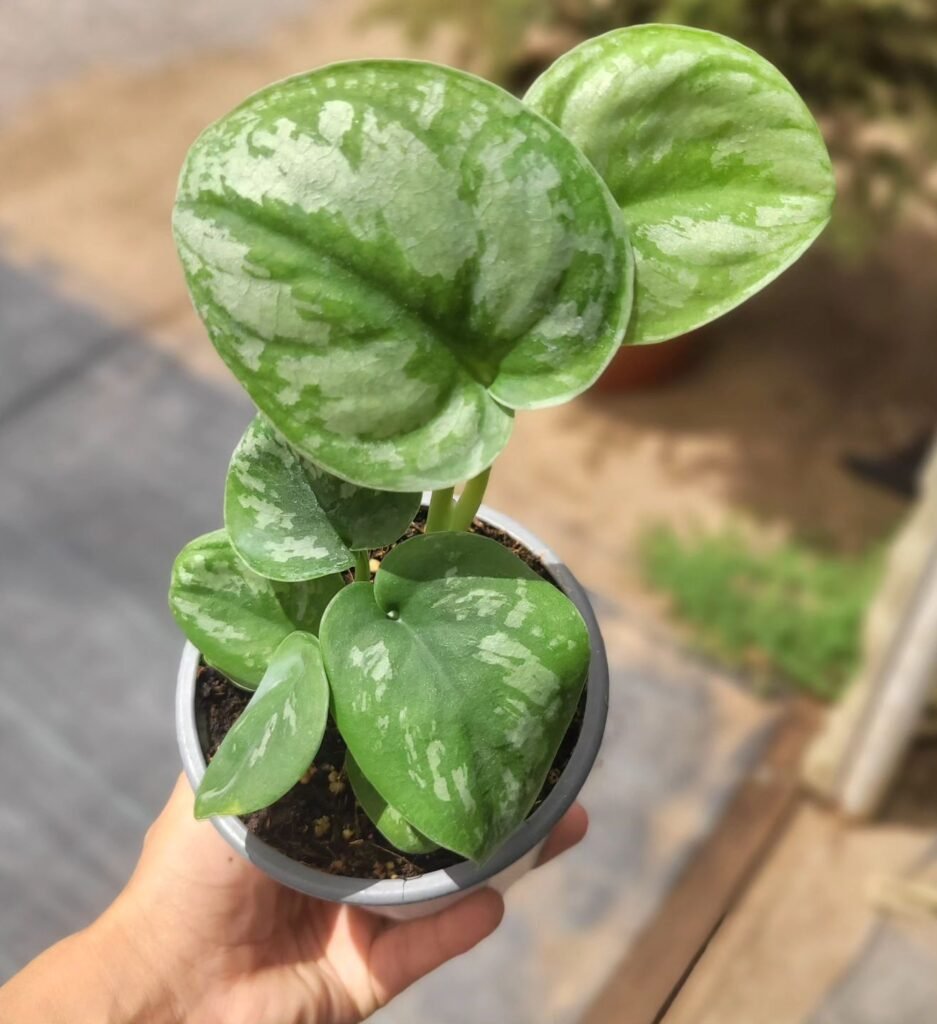
Propagating Scindapsus pictus is a rewarding way to expand your plant collection or share this beautiful plant with friends and family. One of the easiest and most common methods of propagation is through stem cuttings.
In the spring or early summer, select healthy stems with 1 to 2 leaf nodes and about 1 to 2 inches of stem below the cut node. Using clean pruning shears, make a clean cut just below a leaf node. This will encourage new roots to form.
Prepare a wide pot filled with a well-draining potting mix. Dampen the soil slightly and press the nodes of the cuttings into the soil, burying them about an inch deep. Make sure the leaves remain above the soil line.
Place the pot in a location with bright indirect light, such as near a north or east-facing window. Avoid direct sunlight as it can scorch the leaves. Keep the soil evenly moist but not waterlogged, as excessive moisture can lead to root rot.
After about a month, new growth should indicate that the cuttings have successfully rooted. At this point, you can gently tug on the cuttings to check for resistance, which indicates the roots have developed. Once the cuttings have rooted, they can be potted up into individual containers using well-draining potting soil.

Repotting Tips for Scindapsus pictus
Repotting your Silver Vine Pothos is an essential part of its care routine. It should be done when the plant has outgrown its current container or when it needs fresh soil. Here are some tips to help you successfully repot your indoor plant:
- Choose the right container: Select a pot that is slightly larger than the current one to accommodate the growing roots. Ensure that the new pot has drainage holes to prevent waterlogging.
- Prepare the potting mix: Fill the new pot with a fresh indoor potting mix that provides good drainage. A well-draining mix with a mixture of peat moss, perlite, and vermiculite is ideal for Scindapsus pictus.
- Remove the plant from its current pot: Carefully slide the plant out of its current pot, supporting the base of the plant with your hand. Take care not to damage the roots during this process.
- Inspect the roots: Check the roots for any signs of disease or overcrowding. Trim off any damaged or rotting roots using clean and sharp pruning shears.
- Place the plant in the new pot: Gently place the plant into the new pot, ensuring that it sits at the same level as it did in the previous pot. Add more potting mix around the roots, gently pressing it down to secure the plant.
- Water thoroughly: After repotting, water the plant thoroughly until water drains from the bottom of the pot. This will help settle the soil and ensure that the roots make good contact with the new potting mix.
Remember to observe your Scindapsus pictus closely in the days following repotting. Monitor its water needs and adjust your watering schedule accordingly. With proper repotting techniques, your Silver Vine Pothos will continue to thrive and beautify your indoor space.
Common Problems and Solutions for Scindapsus pictus
Scindapsus pictus, known as Silver Vine Pothos, is a beautiful and popular indoor plant. However, like any plant, it can experience some common problems. Below are some of the issues you may encounter with your Scindapsus pictus and how to address them:
Yellow Leaves
One common problem that Scindapsus pictus owners may face is yellow leaves. This can be a sign of overwatering or underwatering. To fix this issue, check the moisture level of the soil. If it is consistently wet, scale back on watering and allow the top two inches of soil to dry before watering again. If the soil is dry, increase watering frequency. Additionally, ensure that the plant is placed in a location with proper lighting and avoid exposing it to direct sunlight.
Curling Leaves
Another problem you may encounter with your Scindapsus pictus is curling leaves. There can be various causes for this issue, including temperature shock, pests, or low humidity. To address curling leaves, ensure that the plant is not exposed to extreme temperatures. Check for any signs of pests such as spider mites or mealybugs and treat them accordingly. Increasing humidity levels around the plant by using a humidifier or placing a tray of water nearby can also help alleviate this problem.
Root Rot
Root rot can be a serious issue for Scindapsus pictus plants if overwatering is not addressed. If you notice brown and mushy roots or a foul odor coming from the soil, it may be a sign of root rot. To treat root rot, remove the plant from its pot and inspect the roots. Trim off any infected roots and repot the plant in fresh, well-draining soil. Adjust your watering practices to prevent overwatering and ensure that the pot has proper drainage.
By addressing these common problems promptly, you can help your Scindapsus pictus thrive and maintain its beautiful foliage. Remember to monitor watering practices, adjust lighting conditions, maintain humidity levels, and address any pest issues to keep your plant healthy and vibrant.
 The Silver Vine Pothos (Scindapsus pictus) stands out with its silver-splashed, heart-shaped leaves and air-cleaning skills, making it both attractive and practical. It’s also a low-light lover, perfect for brightening up dim corners.
The Silver Vine Pothos (Scindapsus pictus) stands out with its silver-splashed, heart-shaped leaves and air-cleaning skills, making it both attractive and practical. It’s also a low-light lover, perfect for brightening up dim corners.
Satin Pothos Varieties
When it comes to Scindapsus pictus, there are a variety of stunning options to choose from. These satin pothos varieties, also known as silver vine pothos cultivars, offer unique leaf patterns and colors that can add a touch of elegance to any indoor space.
One popular variety is the Scindapsus pictus ‘Argyraeus’. This cultivar features smaller, dark green leaves with defined silvery markings. The contrast between the deep green and the silver variegation creates a beautiful and eye-catching display.
Another striking option is the Scindapsus pictus ‘Trebie’. This variety stands out with its highly variegated light green leaves. The leaves of the ‘Trebie‘ cultivar display a mix of green and silvery patterns, creating a vibrant and dynamic appearance.
If you’re looking for a bolder statement, consider the Scindapsus pictus ‘Exotica’. This variety features larger, dark green leaves adorned with large silver splotches. The dramatic contrast between the dark green and silver gives the ‘Exotica‘ cultivar a unique and captivating allure.
Helpful Videos about Scindapsus Pictus (Silver Vine Pothos)
In this carefully selected series, I’ve brought together a collection of videos that walk you through caring for your Scindapsus Pictus, also known as Silver Vine Pothos. Aimed at breaking down the essentials for maintaining the health and vitality of your plant, these resources are designed to be accessible and easy to follow, perfect for gardening newcomers.
FAQ about Growing Scindapsus Pictus (Silver Vine Pothos)

Ever wondered how to properly care for your Scindapsus Pictus? Explore my detailed FAQ for essential advice on nurturing your Silver Vine Pothos to perfection. From the right amount of light, to watering dos and don’ts, and overall plant care, I’ve gathered all the information you’ll need to ensure your plant flourishes.
Your Silver Vine Pothos thrives in bright, indirect light. Avoid direct sunlight as it can scorch the leaves.
Water when the top inch of soil feels dry. Over-watering can lead to root rot, so ensure the pot has good drainage.
Yes, it can tolerate low light but will grow more slowly and with less variegation in the leaves.
It prefers temperatures between 18°C to 29°C. Avoid cold drafts and sudden temperature changes.
Signs include yellowing leaves, wilting, and a musty smell from the soil indicating root rot.
Yes, you can propagate cuttings in water, but for long-term growth, it’s healthier to pot them in soil.
Trimming the long vines encourages the plant to become fuller. Use the cuttings to propagate new plants!
Brown tips can be a sign of too much direct sunlight, low humidity, or water with high fluoride or chlorine levels.
Cut a stem with at least one node and a few leaves, and place it in water or directly into soil. Keep it warm and moist.
Yes, it can be toxic if ingested by pets, causing irritation and other health issues. Keep it out of their reach.
Feed with a balanced, water-soluble fertilizer every 4-6 weeks during the growing season (spring and summer).
This often happens due to insufficient light. Move it to a brighter spot, avoiding direct sunlight.
Wipe leaves with a mild soap solution and inspect regularly. Neem oil can also be effective for persistent problems.
In a house setting, vines can reach up to 3-4 meters in length, but growth can be controlled with regular pruning.
Use a well-draining potting mix. A mix designed for aroids or houseplants is ideal.
Place it on a pebble tray with water or use a humidifier, especially in dry conditions.
Repot every 2-3 years or when it becomes root-bound. Spring is the best time for repotting.
It’s best to keep your Silver Vine Pothos indoors due to the UK’s cooler climate. During summer, you might place it outside in a sheltered, shaded spot, but ensure to bring it in before the temperature drops in autumn.
I hope this aids you in mastering the care of your Scindapsus Pictus. If you’ve got further queries, do pop them in the comments, and I shall respond. Bear in mind, we all begin at the starting line, and there’s perpetually more intriguing insights to discover about your plants.

